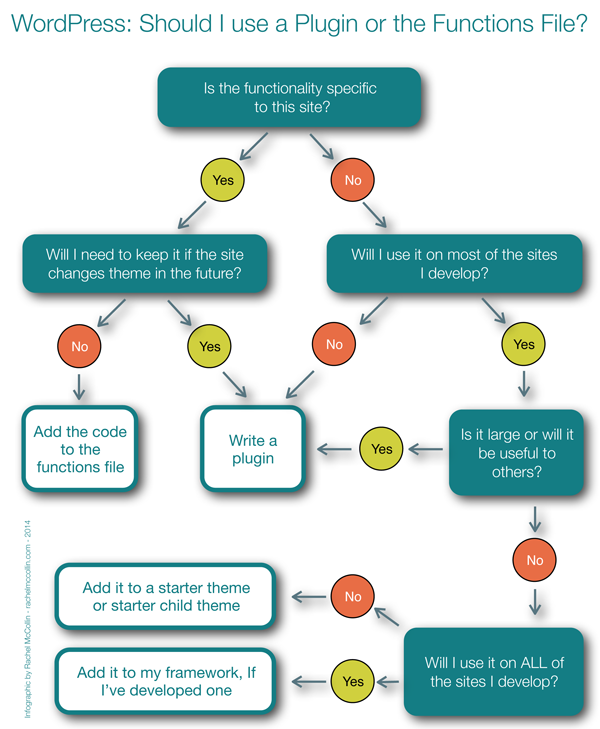在上一课,我们探讨了使用主题框架中子主题创建网站的方式。这节课,让我们来看看需要创建插件的一些情况。
何时创建插件
当你想要给一个建立在框架上的网站添加功能的时候,有时会很难决定是否要使用插件或子主题中的functions.php文件。
在决定做什么之前,我都会问自己几个问题,如以下信息图表所示:

这将帮助你决定是否使用你的子或父主题函数文件、插件,或初始子主题。
如果您添加的功能增加了大量的代码,并能用于你开发的其他但非所有的网站上,那么编写一个插件一般来说是最好的主意。
创建你的插件
如果你决定需要一个插件,那么你可以利用之前添加到框架中的挂钩,使它们变得更强大。例如:
如果你的插件添加了浏览路径记录的功能,你可以将输出钩连到wptp_above_content行动挂钩上,以显示每一网页内容上的浏览路径。
如果你的插件能创建一个更强大的或相关的搜索框,你可以将它附加到wptp_in_header或wptp_sidebar行动挂钩上。
一个创建调用动作框(就像上节课中子主题中的函数)的插件,将附加到wptp_sidebar或wptp_after_content挂钩上。
这样的例子不胜枚举!
显然,也有些插件不会使用框架中的挂钩,而会通过核心WordPress挂钩激活,但是你自己的挂钩会带给你更多的选择。
实例——导航插件
其中一个实例是导航插件,我曾创建此插件并运用到了我自己的框架之中。这个插件仅能在当前页面中被激活,它首先会检查当前页面是否在层次结构中。如果当前页面有子或父页面,它就会显示其层次结构中的顶层页面和其子页面的列表,让你可以进行本地导航。
我在一些客户网站上使用过这个插件,运用其他的一些条件标签将插件附加到before_content挂钩或sidebar挂钩上,或同时附加到两个挂钩上。
该插件使用了两个函数:第一个是wptp_check_for_page_tree(),用于找到页面树中的当前页面:
function wptp_check_for_page_tree() { //start by checking if we're on a page if( is_page() ) { global $post; // next check if the page has parents if ( $post->post_parent ) { // fetch the list of ancestors $parents = array_reverse( get_post_ancestors( $post->ID ) ); // get the top level ancestor return $parents[0]; } // return the id - this will be the topmost ancestor if there is one, or the current page if not return $post->ID; } } |
接下来是wptp_list_subpages(),用于检查我们是否在某个页面上(而不是在主页上),然后运行wptp_check_for_page_tree()函数,并根据其结果,输出页面列表:
function wptp_list_subpages() { // don't run on the main blog page if ( is_page() && ! is_home() ) { // run the wptp_check_for_page_tree function to fetch top level page $ancestor = wptp_check_for_page_tree(); // set the arguments for children of the ancestor page $args = array( 'child_of' => $ancestor, 'depth' => '-1', 'title_li' => '', ); // set a value for get_pages to check if it's empty $list_pages = get_pages( $args ); // check if $list_pages has values if ( $list_pages ) { // open a list with the ancestor page at the top ?> <ul class="page-tree"> <?php // list ancestor page ?> <li class="ancestor"> <a href="<?php echo get_permalink( $ancestor ); ?>"><?php echo get_the_title( $ancestor ); ?></a> </li> <?php // use wp_list_pages to list subpages of ancestor or current page wp_list_pages( $args );; // close the page-tree list ?> </ul> <?php } } } |
安装并激活插件后,你需要在你的子主题中激活它,添加以下内容到functions.php文件:
add_action( 'wptp_sidebar', 'wptp_list_subpages' ); |
当然,如果你想在其他位置输出列表的话,可以使用别的动作挂钩。
小结
插件是这个生态系统的另一部分,而这个生态系统就是你已创建的那部分框架。您可以创建一些插件,并专门设计成通过一些已添加到框架中的挂钩来激活,就像我上面所展示的那样。
在编写一个插件之前,值得花费一些时间去考虑并确定这样做正确与否。如有疑问,请参阅本文前面的信息图表来帮助你下定决心。
- 原文出自:http://code.tutsplus.com/tutorials/developing-plugins-for-your-wordpress-theme-framework–cms-21934
- 由 stonetan@WordPress大学 原创翻译,未经允许,禁止转载和采用本译文。
来源:
https://www.wpdaxue.com/developing-plugins-for-your-wordpress-theme-framework.html



